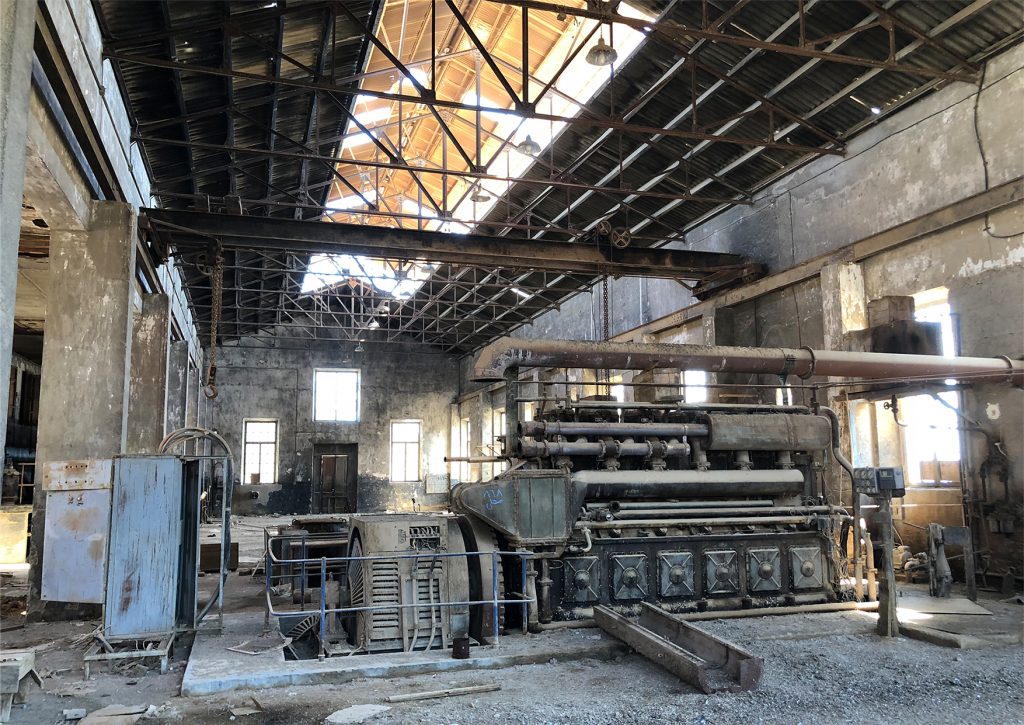What do we want to stand on? مَتي سَنَعتَرِف بتاريخنا الصِناعي؟
For English scroll down…
مَتي سَنَعتَرِف بتاريخنا الصِناعي؟
”التاريخ الصناعي“ جُزء من تاريخ مصر الحديث: شركة فوسفات القصير مازالت تواجه صراع البقاء…
إذا كنت من رواد المدن السياحية علي ساحل البحر الأحمر، لعلك قد سمعت عن مدينة القصير التاريخية التي أشتهرت تاريخياً كهمزة وصل للحجاج من الأراضي المصرية إلي مكة المُكرمة. وإن لم تكن سمعت عنها، فربما قرأت ماتم تناوله علي صفحات التواصل الإجتماعي في العام الماضي بخصوص الجدال حول هدم المباني التاريخية التابعة لشركة الفوسفات التي تملكها شركة النصر للتعدين الآن. ورغم أن قصة هدم المباني التاريخية بمصر، سواء مُسجلة أو غير مُسجلة، ليست بخبر جديد، فإن هذا الطابع العمراني/ المعماري الموجود بشركة الفوسفات بالقصير ربما يُعد الوحيد من هذا النوع في جمهورية مصر العربية. كما أن مدينة القصير هي المدينة الوحيدة علي ساحل البحر الأحمر التي تتميز بخصائص تاريخية ثقافية سياحية، مقارنة بالمدن المجُاورة مثل الغردقة ومرسي علم، اللتان تُقدمان خدمات سياحية ينقصها العامل العمراني والمعماري التاريخي مثل مدينة القصير. هذا المقال لا يتناول تحليل أكاديمي تفصيلي للعناصر العمرانية والمعمارية لشركة الفوسفات. الهدف من هذا المقال هو إعطاء نبذة عن الخصائص التاريخية التي تُسلط ضوءًا بسيطاً عن قيمة الحفاظ علي مثل هذا الموقع بمحتوياته، والذي ينعكس عليه الاختلاف الأزلي عن مدي إدراكنا أو ربما عدمه، بتاريخنا المصري الحديث، وخصوصاً التاريخ الصناعي بمصر.
منذ أكثر من 100 عام، قررت شركة ماركوني الإيطالية الاستثمار وفتح شركة للفوسفات بالقصير عام ١٩٠٦، وذلك لكونها أقرب مدينة لجبل دوي الذي تم اكتشاف واستخراج الفوسفات منه. وعلي الحدود الشمالية لمدينة القصير التاريخية التي كانت ومازالت تتميز بالطابع العمراني والمعماري العثماني، جاء مجموعة من المهندسين الإيطاليين للعمل بمقر الشركة. هؤلاء أتوا من بلدة صغيرة – تقع على بعد 100 كيلومتر شمالاً من مدينة فينيسيا – تسمي Agordo. ثم لحقت بهم أسرهم للاستقرار والعمل. تم اختيار موقع شركة الفوسفات علي الحدود الشمالية لمدينة القصير علي البحر الأحمر لضمان الوصول إلى المناطق المأهولة بالسكان العرب، اللذين تم الأعتماد عليهم كعمالة مُساهمة في أعمال التنقيب. بالإضافة إلى ذلك، تم بناء خط سكة حديد وقاطرة معلقة ”تلفريك“ لسرعة وسهولة الوصول للمناجم بجبل دوي وجبل أبوحمدات.
تم تخطيط أرض شركة الفوسفات لتشمل مستوطنة صغيرة من المباني الصناعية وغيرها لإستضافة العمال الإيطاليين وأُسرهم. لم يقتصر هذا التخطيط علي المباني السكنية فقط، ولكن ضم أيضًا مركز للبحوث الجيولوجية والبحرية، ومطعم، ونادي، وكنيسة لخدمة المستوطنين الإيطاليين داخل مجمع الشركة. كما تم أيضاً بناء مدرسة راهبات للمُستوطنين الإيطاليين، حيث تم لاحقاً السماح لأهل القُصير بالإنضمام لها والدراسة فيها كخطوة للتكامل المُجتمعي. أيضاً. هذا النوع من التشكيل الحَضَري الصناعي يكمن إعتباره كمُستوطنة صناعية صغيرة، حيث يجمع بين العمل والمعيشة في موقع واحد، مجاور للمدينة. هذا النوع من المستوطنات الصناعية التاريخية يوجد بالعديد من الدول الغربية، ولكن شركة الفوسفات بالقصير في الغالب تُعتبر النموذج المتبقي الوحيد في مصر الشاهد علي مثل هذا النوع.
إذا حصلت على إذن بالدخول إلي موقع شركة الفوسفات، فيمكنك التجول في الموقع الكبير وأيضاً في بعض من المباني من الداخل التي لا تزال تعكس رؤية التطور الصناعي بتاريخ مصر الحديثة. وإن كان جزء كبير من المباني مازالت صامدة، فإن الحياة الاجتماعية قد اختفي بمرور الوقت بشكل كبير، حيث لا يوجد أي من السكان الإيطاليين في القصير الآن. ولكن ماتبقي ماهو إلا ذكريات سطحية مازال يتذكرها بعض من كبار السن من سكان مدينة القصير. فمن المؤكد أن إنشاء مصنع الفوسفات وقت ذاك قد أدي إلي أتاحه فرص عمل وتبلور حياة تفاعلية بين الإيطاليين – وبالأخص ”الأجورديين“ – وعرب القصير، مما أثر علي التطور العمراني، والصناعي ، والاجتماعي لمدينة القصير نفسها.
تُعد مُعظم مباني شركة الفوسفات بالقصير اليوم خالية من الحياة ولكنها مليئة بالذكريات، غير مستغلة، إلا الكنيسة التي تخدم أقباط القصير والمناطق المحُيطة بها إلي الآن. وحيث أن المباني لم تؤهل لاستيعاب الاحتياجات المُعاصرة من قِبل شركة النصر للتعدين، فإن المباني تُعد الآن عِبئاً للشركة المالكة علي عكس الموقع نفسه. ويَكمن تقدير شركة النصر للتعدين لقيمة الأرض نفسها دون الهياكل الشامخة عليها. والخطة المُتبعة تشمل هدم مباني وهياكل الشركة وبيع الأرض لبناء مجمع سياحي “مُعاصر”. وقد بدأت هذه الخطة منذ أعوام في التنفيذ وذلك بتفكيك مسارات السكة الحديد التاريخية للشركة وكذلك التلفريك والماكينات وبيعها كَخُردة. وعلي غرار ذلك، فقد أُتيح للأكاديميين والطلبة الجامعيين بزيارة الموقع الذي نال كل الاهتمام الكبير مما أدي إلي زيادة زوار الموقع من باحثين ومصورين وغيرهم.
الآن، تنحصر مشكلة شركة الفوسفات علي نطاقين مختلفين: الأول هو إدراك قيمة موقع الشركة كقطعة أرض قابلة لإعادة الاستخدام والربح فقط إذا تم هدم المباني التي عليها. أما النطاق الآخر، فهو إدراك والاعتراف بقيمة الموقع بما يحتويه من مباني تاريخية وغيرها قابلة لاحيائها واعادة استخدامها وكذلك الربح منها. كلا الرأيين موضوعيين؛ ولكن الرأي الأخير يشير إلي أهمية تقدير واحترام ما تم أرثه لنا – ليس فقط كجزء لا يتجزأ من التاريخ داخل مصر، لكن أيضاً التاريخ المُشترك مع ثقافات مُختلفة. لماذا إذن هدم مثل هذه الشواهد التاريخية الفريدة ومحوها من تاريخنا لمجرد تصميم مجمع سياحي نموذجي متكرر؟ إن مصر تتميز بالكثير من المباني التي شهدت علي تاريخ مصر الحديث وتطورها الصناعي الذي جعل مصر تنافس الدول العظمي في الاقتصاد العالمي. فإن كنا نحن نعتز بآثارنا المصرية القديمة التي تُذكرنا بحضارتنا التي تعتبر مَحط تقدير العالم بأجمعه، فلماذا لا نُعزز قائمة إرثنا التاريخي الحديث – وخصوصاً الصناعي – والاعتراف به؟

شركة الفوسفات بالقصير: لقطة بداخل مبني محطة توليد الكهرباء عام ٢٠١٨. حالياً تم تفريغ المبني من الماكينات التي تم بيعها (Ⓒ ميرهان دمير).
Al-Quseir phosphate company, November 2018: Inside the former power plant building. Presently, the machines have been dismanteled (Ⓒ Mirhan Damir).
What do we want to stand on?
Towards appraising the Industrial Heritage in Egypt: Al-Quseir Phosphate Company still facing its “survival trial”
Along the coast of the Red Sea lies a huge industrial complex in the small touristic city of Al-Quseir: The phosphate company complex, or as I humbly allow myself to call The Egypto-Agordo industrial colony. During the year 2020, and amidst the COVID pandemic, news circulated on social media, reporting on the destruction threat the phosphate industrial complex is confronted with. This is, however, no recent news since the complex has already been standing in decay since years. Besides, and let’s face it, this is not the first historical building/ complex facing demolition in Egypt. However, it is the only historical industrial complex of this type that is located along the coast of the Red Sea. Al-Quseir – comprising a historical city center along the phosphate company – is also the only city that is offering a touristic cultural asset, in comparison to its neighboring touristic cities of Hurghada and Marsa Alam. In this blog, I neither aim at an analytical description of the phosphate complex – as it would fairly need a critical academic writing – nor am I attaining any subjective sympathy towards it. I will just try to simplify this complex’s characteristics and question the inevitable question of valuing our own industrial history. In order to do so, I will just give a brief about its history and significant elements.
More than a 100 years ago, especially in 1906, an Italian family business – the Marconi company – decided to invest and settle in Al-Quseir and open a phosphate complex. Originally coming from the small town of Agordo – 100km north from Venice – many Italians later followed to settle and work/ invest in Al-Quseir. The location of the phosphate company was chosen by the Red Sea on the northern border of Al-Quseir city center to ensure access to the inhabited city as well as to be near the mines at Jabal Duwi and Jabal Abu-Hamādāt, where phosphate was discovered, mined and transported to the industrial complex via a railroad.
Al-Quseir phosphate complex was constructed to comprise a small settlement of industrial structures and other buildings to host a similar living environment for the Italian workers and their families. This did not only consist of residential houses, but also a maritime and geological research center, a restaurant and recreational club, and an Italian school. As Al-Quseir was predominantly characterized as a transit station for pilgrims between Egypt and Mekka for Muslims, a church was constructed to mainly serve the Italian settlers, also inside the walled company complex. Characteristically, the steeple of the church is a copy of the Taibon Agordino, again as a reminder of Agordo. This type of industrial urban cluster where life and work are planned and combined within the same extent, however, adjacent and not integrated within the city’s structure, is found in multiple international examples. In Egypt, on the other hand, this phosphate complex is characteristically an extant outlier.
Until now, if you obtain a permission to enter, you can walk around the gigantic site and even inside the building structures that still stand as a tangible witness of a prosperous part of the city’s history. The intangible, however, is largely gone, since there are no more living residents of the Agordinis in Al-Quseir. Some of the elderly Quseir-ians still hold memories of the once upon a time dual-ethnic industry. It was definitely with the help of the Arab labor that the skilled Agordinis were together able to establish and promote the phosphate industry.
The Egypto-Agordo industrial colony remained walled, its impact nevertheless extended both physically and socially. Regarding the former, the impact of the phosphate company was not solely delimited within its area; with the help of the increasing job opportunities offered by this industry, this inter-social relation in turn played an important role in the urban development of the city of Al-Quseir. The social impact is demonstrated during the second half of the 20th century, where the indigenous children of al-Quseir were allowed to visit the Italian school. Such a “de-colonized” inter-social relation is now by far gone.
The complex, currently owned by Al-Nasr Mining Company (NCM), is inactive and its buildings are mostly left abandoned, except for the church. Unable to fulfill the functional utility, the NMC realizes the urgent need for reuse. However, its perception of reusing lies solely on appreciating the land value itself rather than including the structures within it. The plan was and still is(?) to dismantle the complex’s structure, sell the land to an investor, and perhaps transform it into a touristic compound. The company’s historical rail tracks as well machineries were dismantled and sold as junk. Still, the site is still visited by academics, young scholars, and activists to study and examine the industrial structures in it. Here, in both cases, we find two perceptions of valuing: One that recognizes the worth, potential reuse, and profit of the land only, where the other acknowledges the significance and potential reuse of the whole site. Both perceptions are objective; the only difference if that the latter adds an unbiased appreciation and respect to what our history – as part of our culture – has transmitted to us. Why demolish such a unique historical setting and alter it with a typical touristic compound design? Why does the government still support those keen to impoverish our rich industrial history? While we are demolishing our cultural modern heritage and imitatively building “modern(?)” buildings, the whole world is safeguarding their still-standing historical structures, and even sometimes reconstructing them from scratch. I now will end my article with a quote by the German conservator Ernst-Rainer Hönes: “The cultural heritage is the foundation on which society stands and builds.” So my question here is, what do we really want to stand on? A piece of land, or a piece of history?
:لمزيد من المعلومات عن مصنع الفوسفات بالقصير، برجاء زيارة المصادر التالية
More information on Al-Quseir Phosphate Company are in:
- Pellegrini, Ildo. Agordini a Kosseir: Storia Di Una Communità Nelle Miniere Di Fosfati in Egitto. Feltre: Agorá Libreria Editrice, 2011. https://www.libreriaagora.com/it/agora-editore/storia/agordini-a-kosseir-storia-di-una-comunità-162.html
- Cabassi, Antonella. The Fosfati archives In:: Building Beyond The Mediterranean: Studying The Archives of European Businesses (1860-1970) [Online]. Arles: Publications de l’Institut national d’histoire de l’art, 2012. https://books.openedition.org/inha/12794?lang=de
- Cabassi, Antonella. Kosseir, a phosphate-shipping town In:: Building Beyond The Mediterranean: Studying The Archives of European Businesses (1860-1970) [Online]. Arles: Publications de l’Institut national d’histoire de l’art, 2012. https://books.openedition.org/inha/12734

